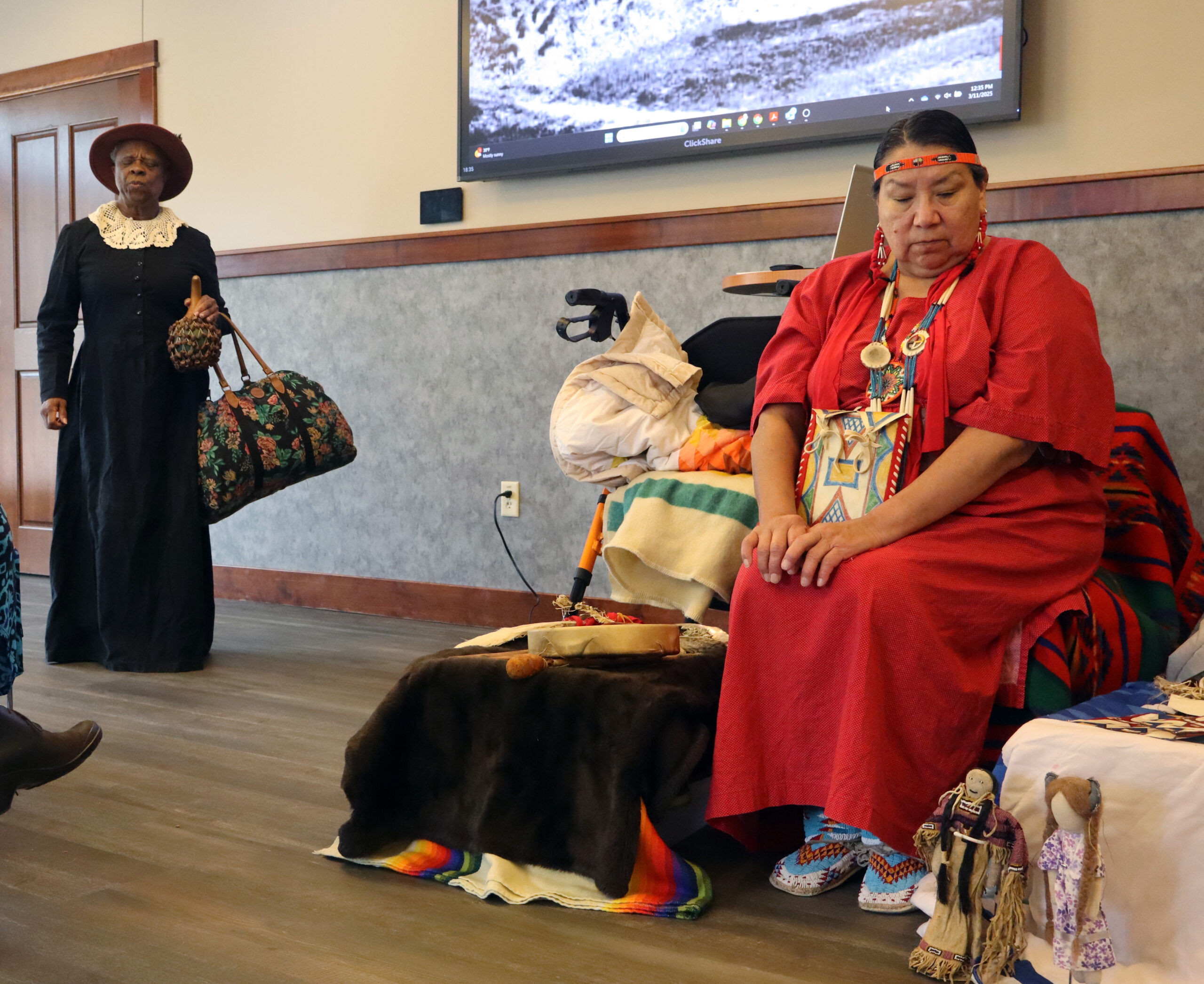From Emancipation to Wounded Knee, Three Dakota Daughters

Joyce Jefferson and Geraldine Goes in Center performing Two Women. Photo by Marnie Cook
SPEARFISH – Dakota Daughters have been presenting their play in celebration of Women’s History Month. They presented “Two Women” in Spearfish last week at the Black Hills State University (BHSU) Women In History Luncheon. They will be performing the full play “Three Women, Three Lives, Three Stories” on March 23 at the Sturgis Community Center hosted by the Sturgis Public Library, to commemorate the 135th anniversary of the December 29, 1890, Wounded Knee Massacre.
The play chronicles, in first person interpretations, the experiences of three women during the settling of the West, the abolishment of slavery and the forced displacement of Native Americans, which ended with the bloody and brutal events near Wounded Knee Creek on the Pine Ridge Indian Reservation when the U.S. opened fire killing hundreds of unarmed Lakota men, women and children.
Joyce Jefferson said Dakota Daughters want to bring awareness to this history, acknowledge the trauma and work toward healing racism.
Jefferson told Native Sun News Today that the inception for the development of the Dakota Daughters program began when she attended the Oscar Micheaux Film Festival which is held in Gregory, South Dakota every year to celebrate the influential Black filmmaker Oscar Micheaux who came to South Dakota to homestead.
She had originally been asked to organize a program and create a performance that portrays the African American experience of settling the West. Jefferson said she had received a grant from the South Dakota Humanities Council (SDHC) for another project. “They suggested that we try the Wounded Knee Massacre, because there were Euro Americans there, there were Native Americans there and the Buffalo Soldiers were there.” The SDHC gave her a grant extension to apply to developing the Dakota Daughters program. The program eventually evolved into a format where each participant shares their story, progressively telling the history. “After we did that one show, it seemed to be so popular, it became part of the South Dakota Humanities Council during a grant season opening.”
Most of the characters and stories are fictional but based on historical events and personal family narratives. The characters Jefferson brings to life, however, were living people. She tells the stories of three pioneer African American Women – Sarah Campbell, Lucretia Marchbanks and Mary Kercherval who crossed dangerous and undeveloped land as they traveled to Dakota Territory.
Sarah Campbell, who made her way from Kentucky to Dakota Territory, is considered one of the early entrepreneurs in the Black Hills. She was twelve when she was to have been given her freedom, but she was instead sold to Henry Choteau, cousin to Pierre Choteau, the founder of Fort Pierre in Dakota Territory. She was hired out as a cook on a steamboat that traveled between Yankton and Bismarck when she met a lawyer who helped her prove that her continued enslavement was illegal. Slavery was forbidden on territory gained through the Louisiana Purchase, but it still existed in spite of the Missouri Compromise of 1820. Campbell gained her freedom and eventually became the first Black woman to own property and an independent business in Bismarck, North Dakota, where she as a respected business woman for more than 30 years.
In June of 1872, Campbell was hired to cook and launder for soldiers, teamsters and others providing services to the 7th Cavalry as they illegally entered the Black Hills. She later returned to the Black Hills and became the first woman to claim a gold mining site at French Creek.
Geraldine Goes In Center (Oglala Lakota), tells the story of Kimimila the daughter of Sitting Bull as she and her daughter are food gathering. She is sharing stories with her daughter and passing on traditional ways as they gather food together, offering their wasna as thanks to Mother Earth for providing food for the upcoming year, picking chokecherries and teaching her how to dig turnip roots and braid them. “Cunksi, we have been coming here as long as I can remember. I was thinking that when you grow up and if you have a daughter, you will bring her here too. Isn’t this a beautiful place? This is our home,” Kimimila tells her daughter, “and will be our home forever.”
Goes In Center presents food and diet of the Lakota, from Kimimila’s prereservation experience, with information about the food they consumed and how they prepared and preserved it. “I didn’t bring any today,” Goes In Center told Native Sun News at the Spearfish presentation, “but I usually bring samples of my wasna.”
Jefferson said that Lillian Witt portrays a woman born in the south who travels to Dakota Territory to settle. Her attitudes change over the course of time.
The story begins right after the Civil War and ends at on that bitterly cold day at Wounded Knee. Although the women depicted come from distinctly different backgrounds, their lives become interconnected in the retelling of this American history.
Dakota Daughters have committed to disseminating this story across South Dakota, ensuring that historical information is conveyed in an engaging, thought-provoking, entertaining, and memorable manner. Their stated hope is that when people see their play, they will realize that although “we all are unique – such as skin color, cultures, beliefs – deep down we are not all that different.”
The free play is a collaborative program with Black Hills Parks and Forests Association (BHPFA), the Sturgis Public Library and the SDHC. Doors open at 1 pm at the Sturgis Community Center. There will be refreshments as well as women-owned vendors. The presentation will start at 2:00 pm. There will be a Q & A session with the presenters, and door prizes from local women-owned businesses.
(Contact Marnie Cook cookm8715@gmail.com)
The post From Emancipation to Wounded Knee, Three Dakota Daughters first appeared on Native Sun News Today.
Tags: More News
